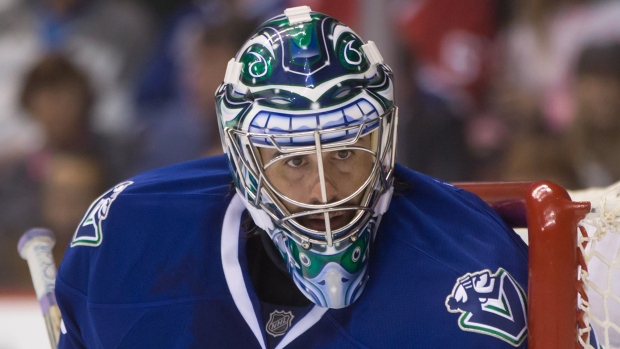Dec 7, 2014
Paterson: The curious case of Miller's season, period by period
It's pretty clear that third periods are Miller time. Second periods, however, are not. And the difference between the two is a head-scratcher. Jeff Paterson of TSN Radio 1040 breaks down Ryan Miller's vastly different numbers between the three periods and tries to explain why the second frame has been the goalie's achilles heel this season.

VANCOUVER – It's pretty clear that third periods are Miller time. Second periods, however, are not. And the difference between the two is a head-scratcher.
After getting the hook 5:39 into the second on Saturday night in Toronto, Ryan Miller's performance got me thinking (which is always a dangerous exercise). It started with a simple question: how can the same guy be among the National Hockey League leaders with 16 victories but also have been lifted in three of his five defeats? And since Miller has been pulled three times (including each of the last two Saturday appearances), I began wondering about his save percentage late in the hockey games he finished. Because when he's been on top of his game, it has almost always been in third periods this season when he's been able to shut the door and preserve victories for the hockey club. And as it turns out, his third period performances are off the charts good – one of the big reasons Miller is 7-0 in one-goal games so far this season.
But getting to the third period has at times proved problematic. And so the project became a closer look at the goals Miller has allowed and his save percentage period by period. The results are startling. The following chart lays out Miller's body of work so far, broken down into the three periods and overtime:
Ryan Miller in 2014-15 season
| PERIOD | GOALS | SHOTS | SAVE PCT. |
|---|---|---|---|
| 1 | 17 | 176 | 90.3 |
| 2 | 26 | 183 | 85.8 |
| 3 | 8 | 174 | 95.4 |
| OT | 0 | 1 | 100 |
| TOTAL | 51 | 534 | 90.4 |
The shot totals for each of the three periods are similar and in the case of first and third periods almost identical. So it's not like Miller's workload has increased dramatically from one period to the next. But the goals allowed are inexplicable. Sure, the second period has the long change for both teams and that may lead to a few more scoring chances, but not enough to blow the doors off.
How can a netminder allow more than three times as many goals in the second period as he does in the third? And twice as many goals in the first frame as the final one? His third period save percentage would win him the Vezina in a heartbeat if he could play that way all night, every night. But his second period save percentage wouldn't allow him to keep his job in the NHL if his numbers were like that across the board.
It's been made clear since the day he signed with the Canucks that Ryan Miller is a rhythm goalie and the period-by-period breakdown is simply more irrefutable proof. When he's on his game and in a groove, Miller has been terrific for the Canucks in third periods this season, giving up just eight goals in the final periods of hockey games. And only once – October 30 versus Montreal – has Miller surrendered more than a single goal in any of the 18 third periods he's played. The Habs got to him twice that night, but he still pulled out an overtime victory.
Contrast that with the fact that twice this season Miller has been torched for three goals in first periods and on two other occasions it has happened to him in seconds. He has allowed multiple goals in the first period six times in his 21 starts and nine times in second periods. When Miller gets off to a tough start, it has at times been a struggle to regain his form and focus.
But on the nights Ryan Miller successfully navigates his personal mine fields, he has been a remarkable closer.
While the numbers in the table above outline Miller's season as a whole, the pattern has held true on the Canucks' current road trip. Has has allowed four first period goals, five second period markers and has surrendered just a pair of third period goals. And over that time, he has posted a shutout in Columbus, been pulled in Toronto and split his results in Detroit and Washington.
It's hard to figure out after all these years how a veteran of so many NHL battles still needs time to work his way into games. And harder still to make sense of why when he's on everything is great, but when he's not he has trouble surviving second periods.
Ultimately, hockey is a results-oriented business and Ryan Miller's bottom line looks awfully good at 16-5 despite having his evening cut short on Saturday. Without question, he's been a big part of the Canucks success this season. He's developed a knack of being there when the Canucks need him most and the numbers show he's been very good when games are on the line.
So sure there may have been some potholes in the first 40 minutes of hockey games so far this season, but it's pretty evident that third periods have been Miller time.


